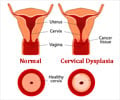
‘Exploring the genetic variants may provide the answer on why cervical cancer is less common in certain regions of the world.’
Tweet it Now
Approximately eight out of 10 cervical cancer deaths worldwide occur in low- and middle-income countries, but a few geographical regions--such as Western Asia including Saudi Arabia--have low cervical cancer rates despite the lack of national screening or vaccination programs against human papillomavirus (HPV), which is transmitted sexually and is the main cause of cervical cancer.Ghazi Alsbeih, MD, PhD, of the King Faisal Specialist Hospital & Research Centre in Saudi Arabia, and his colleagues collected tumor samples and demographic data from 232 patients treated for invasive cervical cancers and compared the information with 313 matched controls without cancer.
The researchers found that cervical cancer in their Saudi national cohort displayed two peaks of increased incidence at 43 and 61 years of age. "As cancer development takes years to decades, the first peak could be a consequence of early sexual encounters, which often occurs at the end of the teenage period to the early thirties, while the second rebound could correspond to new encounters later in life," explained Dr. Alsbeih. "The latter is generally occasioned by separation, failure of a first marriage, or simply second marriages in polygamous societies, which brings in an added risk of HPV infections as the number of lifetime sexual partners increases."
Worldwide, 85 percent to 99 percent of patients with cervical cancer are HPV-positive, but in this study, only 77 percent were.
Dr. Alsbeih and his colleagues looked to genetics to explore why cervical cancer rates may be lower in Saudi Arabia than in other regions such as the United States. They found that HPV-negative patients in this study were more likely to show a particular variant in the gene that encodes the p53 tumor suppressor protein: a cytosine (C) rather than a guanine (G) in the DNA code, which leads to the production of a proline rather than an arginine amino acid in the translated protein.
Advertisement
Though the G allele is considered the majority allele, the C variant was more commonly observed in this cohort than it is in populations from other parts of the world that show higher incidences of cervical cancer.
Advertisement
Source-Eurekalert














